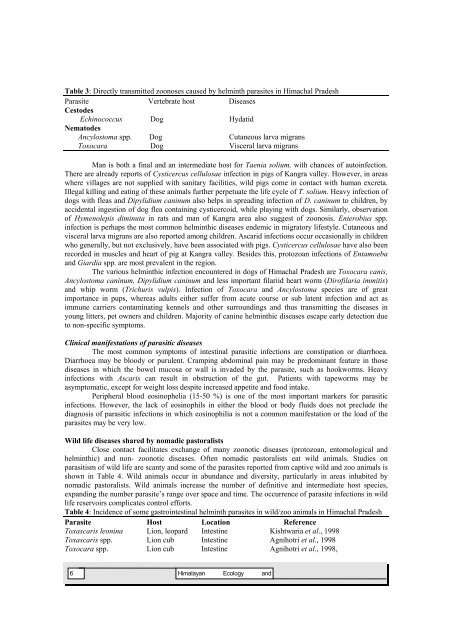bagwani vikas evam prasar pariyojna in district champawat
bagwani vikas evam prasar pariyojna in district champawat
bagwani vikas evam prasar pariyojna in district champawat
- No tags were found...
Create successful ePaper yourself
Turn your PDF publications into a flip-book with our unique Google optimized e-Paper software.
Table 3: Directly transmitted zoonoses caused by helm<strong>in</strong>th parasites <strong>in</strong> Himachal PradeshParasite Vertebrate host DiseasesCestodesEch<strong>in</strong>ococcus Dog HydatidNematodesAncylostoma spp. Dog Cutaneous larva migransToxocara Dog Visceral larva migransMan is both a f<strong>in</strong>al and an <strong>in</strong>termediate host for Taenia solium, with chances of auto<strong>in</strong>fection.There are already reports of Cysticercus cellulosae <strong>in</strong>fection <strong>in</strong> pigs of Kangra valley. However, <strong>in</strong> areaswhere villages are not supplied with sanitary facilities, wild pigs come <strong>in</strong> contact with human excreta.Illegal kill<strong>in</strong>g and eat<strong>in</strong>g of these animals further perpetuate the life cycle of T. solium. Heavy <strong>in</strong>fection ofdogs with fleas and Dipylidium can<strong>in</strong>um also helps <strong>in</strong> spread<strong>in</strong>g <strong>in</strong>fection of D. can<strong>in</strong>um to children, byaccidental <strong>in</strong>gestion of dog flea conta<strong>in</strong><strong>in</strong>g cysticercoid, while play<strong>in</strong>g with dogs. Similarly, observationof Hymenolepis dim<strong>in</strong>uta <strong>in</strong> rats and man of Kangra area also suggest of zoonosis. Enterobius spp.<strong>in</strong>fection is perhaps the most common helm<strong>in</strong>thic diseases endemic <strong>in</strong> migratory lifestyle. Cutaneous andvisceral larva migrans are also reported among children. Ascarid <strong>in</strong>fections occur occasionally <strong>in</strong> childrenwho generally, but not exclusively, have been associated with pigs. Cysticercus cellulosae have also beenrecorded <strong>in</strong> muscles and heart of pig at Kangra valley. Besides this, protozoan <strong>in</strong>fections of Entamoebaand Giardia spp. are most prevalent <strong>in</strong> the region.The various helm<strong>in</strong>thic <strong>in</strong>fection encountered <strong>in</strong> dogs of Himachal Pradesh are Toxocara canis,Ancylostoma can<strong>in</strong>um, Dipylidium can<strong>in</strong>um and less important filariid heart worm (Dirofilaria immitis)and whip worm (Trichuris vulpis). Infection of Toxocara and Ancylostoma species are of greatimportance <strong>in</strong> pups, whereas adults either suffer from acute course or sub latent <strong>in</strong>fection and act asimmune carriers contam<strong>in</strong>at<strong>in</strong>g kennels and other surround<strong>in</strong>gs and thus transmitt<strong>in</strong>g the diseases <strong>in</strong>young litters, pet owners and children. Majority of can<strong>in</strong>e helm<strong>in</strong>thic diseases escape early detection dueto non-specific symptoms.Cl<strong>in</strong>ical manifestations of parasitic diseasesThe most common symptoms of <strong>in</strong>test<strong>in</strong>al parasitic <strong>in</strong>fections are constipation or diarrhoea.Diarrhoea may be bloody or purulent. Cramp<strong>in</strong>g abdom<strong>in</strong>al pa<strong>in</strong> may be predom<strong>in</strong>ant feature <strong>in</strong> thosediseases <strong>in</strong> which the bowel mucosa or wall is <strong>in</strong>vaded by the parasite, such as hookworms. Heavy<strong>in</strong>fections with Ascaris can result <strong>in</strong> obstruction of the gut. Patients with tapeworms may beasymptomatic, except for weight loss despite <strong>in</strong>creased appetite and food <strong>in</strong>take.Peripheral blood eos<strong>in</strong>ophelia (15-50 %) is one of the most important markers for parasitic<strong>in</strong>fections. However, the lack of eos<strong>in</strong>ophils <strong>in</strong> either the blood or body fluids does not preclude thediagnosis of parasitic <strong>in</strong>fections <strong>in</strong> which eos<strong>in</strong>ophilia is not a common manifestation or the load of theparasites may be very low.Wild life diseases shared by nomadic pastoralistsClose contact facilitates exchange of many zoonotic diseases (protozoan, entomological andhelm<strong>in</strong>thic) and non- zoonotic diseases. Often nomadic pastoralists eat wild animals. Studies onparasitism of wild life are scanty and some of the parasites reported from captive wild and zoo animals isshown <strong>in</strong> Table 4. Wild animals occur <strong>in</strong> abundance and diversity, particularly <strong>in</strong> areas <strong>in</strong>habited bynomadic pastoralists. Wild animals <strong>in</strong>crease the number of def<strong>in</strong>itive and <strong>in</strong>termediate host species,expand<strong>in</strong>g the number parasite’s range over space and time. The occurrence of parasite <strong>in</strong>fections <strong>in</strong> wildlife reservoirs complicates control efforts.Table 4: Incidence of some gastro<strong>in</strong>test<strong>in</strong>al helm<strong>in</strong>th parasites <strong>in</strong> wild/zoo animals <strong>in</strong> Himachal PradeshParasite Host Location ReferenceToxascaris leon<strong>in</strong>a Lion, leopard Intest<strong>in</strong>e Kishtwaria et al., 1998Toxascaris spp. Lion cub Intest<strong>in</strong>e Agnihotri et al., 1998Toxocara spp. Lion cub Intest<strong>in</strong>e Agnihotri et al., 1998,6Himalayan Ecology and
















